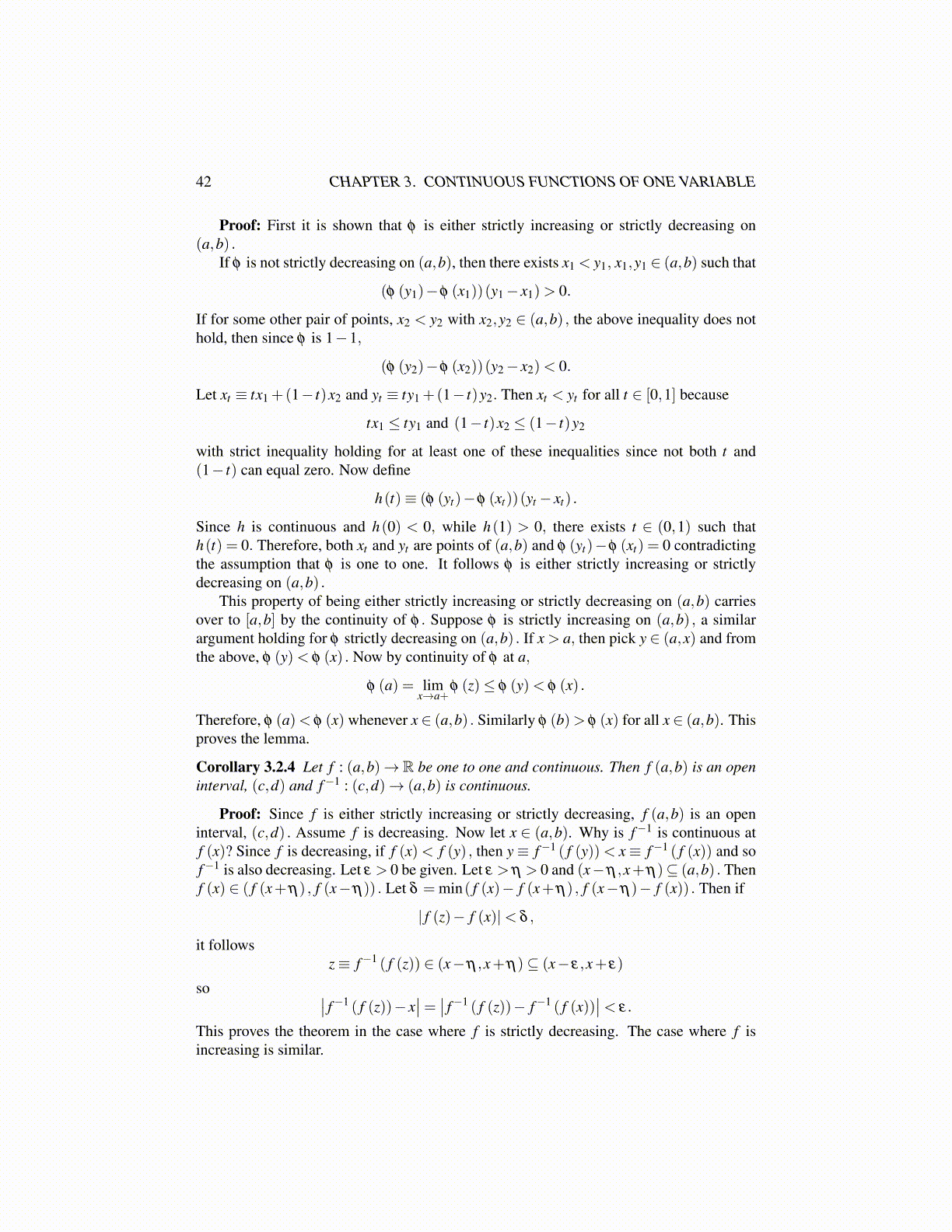
42 CHAPTER 3. CONTINUOUS FUNCTIONS OF ONE VARIABLE
Proof: First it is shown that φ is either strictly increasing or strictly decreasing on(a,b) .
If φ is not strictly decreasing on (a,b), then there exists x1 < y1, x1,y1 ∈ (a,b) such that
(φ (y1)−φ (x1))(y1− x1)> 0.
If for some other pair of points, x2 < y2 with x2,y2 ∈ (a,b) , the above inequality does nothold, then since φ is 1−1,
(φ (y2)−φ (x2))(y2− x2)< 0.
Let xt ≡ tx1 +(1− t)x2 and yt ≡ ty1 +(1− t)y2. Then xt < yt for all t ∈ [0,1] because
tx1 ≤ ty1 and (1− t)x2 ≤ (1− t)y2
with strict inequality holding for at least one of these inequalities since not both t and(1− t) can equal zero. Now define
h(t)≡ (φ (yt)−φ (xt))(yt − xt) .
Since h is continuous and h(0) < 0, while h(1) > 0, there exists t ∈ (0,1) such thath(t) = 0. Therefore, both xt and yt are points of (a,b) and φ (yt)−φ (xt) = 0 contradictingthe assumption that φ is one to one. It follows φ is either strictly increasing or strictlydecreasing on (a,b) .
This property of being either strictly increasing or strictly decreasing on (a,b) carriesover to [a,b] by the continuity of φ . Suppose φ is strictly increasing on (a,b) , a similarargument holding for φ strictly decreasing on (a,b) . If x > a, then pick y ∈ (a,x) and fromthe above, φ (y)< φ (x) . Now by continuity of φ at a,
φ (a) = limx→a+
φ (z)≤ φ (y)< φ (x) .
Therefore, φ (a)< φ (x) whenever x ∈ (a,b) . Similarly φ (b)> φ (x) for all x ∈ (a,b). Thisproves the lemma.
Corollary 3.2.4 Let f : (a,b)→ R be one to one and continuous. Then f (a,b) is an openinterval, (c,d) and f−1 : (c,d)→ (a,b) is continuous.
Proof: Since f is either strictly increasing or strictly decreasing, f (a,b) is an openinterval, (c,d) . Assume f is decreasing. Now let x ∈ (a,b). Why is f−1 is continuous atf (x)? Since f is decreasing, if f (x)< f (y) , then y≡ f−1 ( f (y))< x≡ f−1 ( f (x)) and sof−1 is also decreasing. Let ε > 0 be given. Let ε > η > 0 and (x−η ,x+η)⊆ (a,b) . Thenf (x) ∈ ( f (x+η) , f (x−η)) . Let δ = min( f (x)− f (x+η) , f (x−η)− f (x)) . Then if
| f (z)− f (x)|< δ ,
it followsz≡ f−1 ( f (z)) ∈ (x−η ,x+η)⊆ (x− ε,x+ ε)
so ∣∣ f−1 ( f (z))− x∣∣= ∣∣ f−1 ( f (z))− f−1 ( f (x))
∣∣< ε.
This proves the theorem in the case where f is strictly decreasing. The case where f isincreasing is similar.